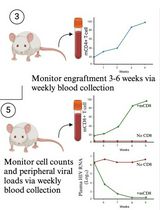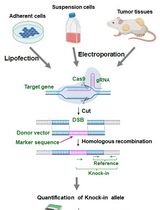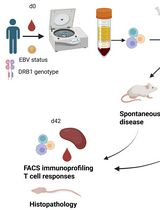- EN - English
- CN - 中文
Parasitemia Evaluation in Mice Infected with Schistosoma mansoni
曼氏血吸虫感染小鼠的寄生虫病评估
发布: 2021年05月20日第11卷第10期 DOI: 10.21769/BioProtoc.4017 浏览次数: 4446
评审: Alexandros AlexandratosEmilie ViennoisAnonymous reviewer(s)
Abstract
Schistosomiasis is a neglected tropical disease. Its treatment relies on the use of a single drug, praziquantel. Due to treatment limitations, an alternative for schistosomiasis chemotherapy is required; thus, a better understanding of parasite biology and host-parasite interactions is valuable to aid the identification of new anti-Schistosoma drugs. The parasite has a complex life cycle, which results in challenges regarding the evaluation of Schistosoma mansoni development and mammalian infection establishment. Accordingly, this protocol describes methodologies to evaluate: (1) adult worm growth; (2) reproduction; and (3) granuloma formation; and consequently allows more comprehensive knowledge of S. mansoni development in a natural biological system.
Keywords: Schistosoma mansoni (曼氏血吸虫)Background
Schistosomiasis is a neglected tropical disease currently endemic in 78 countries (World Health Organization, 2018). Five Schistosoma species can cause parasitosis and are distributed in Asia, Africa, and the Americas. There are two distinct forms of the disease: urogenital, caused by Schistosoma haematobium; and intestinal, caused by Schistosoma intercalatum, Schistosoma mekongi, Schistosoma japonicum, and Schistosoma mansoni (Uberos and Jerez-Calero, 2012; World Health Organization, 2018). Humans are infected following contact with cercariae released from infected aquatic snails.
Here, we focus on the S. mansoni species. After entering a mammalian host, cercariae differentiate into schistosomula (Hitchcock, 1949; de Waard and Vermeulen, 1961; Stirewalt, 1974), which migrate to intrahepatic vessels and develop in adults (Armstrong, 1965; Miller and Wilson, 1980). After mating, the adult worms migrate to the mesenteric veins, where they complete their development and start laying eggs after the 35th day of infection. A female adult worm lays about 300 eggs per day, which reach tissues and the intestinal lumen and are eliminated along with the feces to the external environment (Moore and Sandground, 1956; Gryseels et al., 2006). However, some eggs become trapped in the liver and induce the formation of granulomatous lesions (Espírito Santo et al., 2008; King and Dangerfield-Cha, 2008), which can lead to fibrosis in host tissues and the promotion of injuries and complications that cause anemia, malnutrition, and loss of quality of life, having a high socioeconomic impact (Burke et al., 2009; Olveda et al., 2017).
Schistosomiasis treatment relies on the use of praziquantel, which displays activity against all species; although, immature worms are not affected (Watson, 2009; Thétiot-Laurent et al., 2013). Additionally, there are reports of adult worms with reduced sensitivity to praziquantel, reinforcing the need for alternative schistosomicidal drugs (Fallon and Doenhoff, 1994; Ismail et al., 1994 and 1996, Engels et al., 2002; Caffrey and Secor, 2011). Therefore, parasite biology and host-parasite interaction studies are a feasible strategy to search for new anti-Schistosoma drugs.
As described, S. mansoni presents a complex life cycle that requires two hosts; thus, a better understanding of parasite biology is challenging, demanding, specialized labor, and time consuming (Clegg, 1965; Michaels and Prata, 1968; Basch, 1981; Irie et al., 1987). Inoculation of animal models with parasites is a way to investigate S. mansoni development in the mammalian host, being an approachable procedure and an important system for the evaluation of the complex host-parasite interaction.
Here, we describe a protocol to assess the development of S. mansoni inside a mammalian host. The following procedures detail how to perform a mouse infection with schistosomula and describe methods to evaluate parasite development, such as growth, reproduction, and infection outcome through granuloma analysis in the liver.
Materials and Reagents
1-ml insulin syringe with a 27 G needle (BD, catalog number:309623)
21 G needle (BD, catalog number: 305129)
Plastic Pasteur pipettes (Kasvi, catalog number: K30-300S)
Petri dishes (Sarstedt, catalog number: 82.1473.001)
6-well plates (Sarstedt, catalog number: 83.3920.300)
50-ml conical centrifuge tubes (Sarstedt, catalog number: 62.547.254)
15-ml conical centrifuge tubes (Sarstedt, catalog number: 62.554.205)
Scalpel (CP Lab Safety, catalog number: QC-793-140-EA)
1-200 µl universal tips (Axygen, catalog number: T-200-Y)
100-1,000 µl universal tips (Axygen, catalog number: T-1000-B)
Maxymum Recovery® 0.6-ml microfuge tubes (Axygen, catalog number: MCT-060-L-C)
0.6-ml microfuge tubes (Axygen, catalog number: MCT-060-C-S)
1.5-ml microfuge tubes (Axygen, catalog number: MCT-150-C-S)
Microscope slides, 26 × 76 mm (KASVI, catalog number: K5-7105)
Microscope slide coverslips, 24 × 24 mm (KASVI, catalog number: K5-2424)
Microscope slide coverslips, 24 × 50 mm (KASVI, catalog number: K5-2450)
High-profile disposable blades 818 (Leica Biosystems, catalog number: 14035838383)
Biopsy cassette (CRALPLAST, catalog number: 2921)
Female Swiss Webster mice, 28 days old
Glasgow Minimum Essential Medium (GMEM) (Sigma-Aldrich, catalog number: G6148)
Glucose (Sigma-Aldrich, catalog number: G5767)
Lactalbumin (Sigma-Aldrich, catalog number: L7252)
HEPES (Sigma-Aldrich, catalog number: H3375)
Fetal bovine serum (Thermo Fisher Scientific, Gibco, catalog number: 16000044)
MEM vitamin solution (Thermo Fisher Scientific, Gibco, catalog number: 16000044)
Schneider’s Insect Medium (Sigma-Aldrich, catalog number: S0146)
Triiodothyronine (Sigma-Aldrich, catalog number: 709611)
Hypoxanthine (Sigma-Aldrich, catalog number: H9636)
Hydrocortisone (Sigma-Aldrich, catalog number: H0888)
Penicillin/streptomycin (Thermo Fisher Scientific, Gibco, catalog number: 15070063)
Sodium heparin (Fisher Scientific, Thermo Fisher Scientific, catalog number: BP252410)
NaCl (Merck Millipore, catalog number: 1064040500)
Xylazine hydrochloride (Sigma-Aldrich, catalog number: X1251)
Ketamine hydrochloride (Sigma-Aldrich, catalog number: 343099)
Sodium thiopental (Sigma-Aldrich, catalog number: T6023)
KOH (Sigma-Aldrich, catalog number: 221473)
Absolute ethanol (Merck Millipore, catalog number 64175)
36% formaldehyde (Sigma-Aldrich, catalog number: 47608)
Glacial acetic acid (Merck Millipore, catalog number: 64197)
HCl (Merk Millipore, catalog number: 109057)
Carmine (Sigma-Aldrich, catalog number: C1022)
Methyl salicylate (Sigma-Aldrich, catalog number: M6752)
Canada balsam (Sigma-Aldrich, catalog number: 60610)
N-butyl acetate (Sigma-Aldrich, catalog number: 442666-U)
Histological paraffin (Easypath, catalog number: EP-21-20068A)
Hematoxylin (Sigma-Aldrich, catalog number: H3136)
Eosin (Sigma-Aldrich, catalog number: E4009)
Xylene (Sigma-Aldrich, catalog number: 534056)
Entellan (Merck Millipore, catalog number: 1079610100)
Autoclaved tap water
Autoclaved balanced feed for mice
0.85% NaCl (see Recipes)
10% KOH (see Recipes)
1× PBS (see Recipes)
4% buffered formaldehyde (see Recipes)
10% formaldehyde (see Recipes)
Alcohol-formalin-acetic Acid (AFA) (see Recipes)
70% ethanol (see Recipes)
80% ethanol (see Recipes)
90% ethanol (see Recipes)
95% ethanol (see Recipes)
Hydrochloric carmine (see Recipes)
Hydrochloric alcohol (see Recipes)
1:2 methyl salicylate-Canada balsam (see Recipes)
Supplemented GMEM (see Recipes)
Equipment
Tweezers (CP Lab Safety, catalog number: QC-788-100-EA)
Dissecting scissors (CP Lab Safety, catalog number: QC-791-107-EA)
Perfusion system (AutoMate Scientific, catalog number: 11-140)
200-ml glass beaker
5-mm sieve
Manual 2-20 µl single-channel pipette (Eppendorf, catalog number: 3120000038)
Manual 20-200 µl single-channel pipette (Eppendorf, catalog number: 3120000054)
Manual 100-10,00 µl single-channel pipette (Eppendorf, catalog number: 3120000062)
Eppendorf® Centrifuge 5804R (Sigma-Aldrich, catalog number: EP022628146)
Tissue processing PT05 TS (Lupetec)
Inclusion Center CI 2014 (Lupetec)
Aluminum inclusion molds (Lupetec)
Microtome MRP2015 (Lupetec)
Light microscope Axiostar Plus (Zeiss)
Zeiss microscope Stemi SV 11 (Zeiss)
Inverted microscope Axio Vert (Zeiss)
Inverted microscope Eclipse Ti-E (Nikon) with Confocal C2 plus (Nikon)
Software
ImageJ (Schneider et al., 2012) (https://imagej.net/ImageJ1)
NIS-Elements software (Nikon)
Procedure
文章信息
版权信息
© 2021 The Authors; exclusive licensee Bio-protocol LLC.
如何引用
Tavares, N. C. and Mourão, M. M. (2021). Parasitemia Evaluation in Mice Infected with Schistosoma mansoni. Bio-protocol 11(10): e4017. DOI: 10.21769/BioProtoc.4017.
分类
微生物学 > 微生物-宿主相互作用
免疫学 > 动物模型 > 小鼠
生物科学 > 生物技术
您对这篇实验方法有问题吗?
在此处发布您的问题,我们将邀请本文作者来回答。同时,我们会将您的问题发布到Bio-protocol Exchange,以便寻求社区成员的帮助。
Share
Bluesky
X
Copy link














